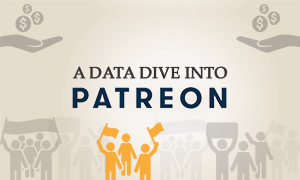 As long-time readers will know, I’m keen to cover the speed and scope of changes within the film business. The industry has experienced a greater degree of flux in the past decade than in the previous century, and yet more shape-shifting is on the horizon. This transformation makes it a fascinating time to be entering or studying the film industry.
As long-time readers will know, I’m keen to cover the speed and scope of changes within the film business. The industry has experienced a greater degree of flux in the past decade than in the previous century, and yet more shape-shifting is on the horizon. This transformation makes it a fascinating time to be entering or studying the film industry.
One of the areas of significant change is the evolving relationship between artists and audiences. Historically, there have been many levels of middlemen between the artists (i.e. writers, directors, actors, etc) and their audience (i.e. the people who actually pay to watch their work). Money and feedback from audiences flowed back to artists via a long chain of studios, sales agents, distributors, exhibitors, retailers and broadcasters, meaning that in practice there was very little connection. Fans of a particular director had no way of communicating with them, least of all supporting them directly.
Added to that, this chain of middle men is expensive and everyone needs to have their cut. This means that there is a push towards safer, broader films in order to gain the widest possible audience. Niche and fringe artists are penalised or forgotten altogether.
However, in the modern age, we’re starting to see challenges to this structure. Digital technologies are allowing artists to create work cheaply, distribute it worldwide for free and build active relationships with their fans. It’s that last innovation that I’m going to focus on today.
I have already covered one form of audience-powered funding in a lot of detail – crowdfunding (here, here, here, here and here). This is where many people pay small amounts of money up-front for a piece of work that hasn’t been created yet. Pay today, access the content in the future. A different but similar model is used by the website Patreon.
Patreon 101
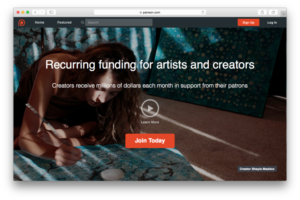 Patreon allows fans to pledge regular small amounts of money to an artist in return for exclusive content and access to that artist. It is especially popular with people making regular YouTube videos, although they also cover all manner of artists and services. Patreon describes their philosophy as:
Patreon allows fans to pledge regular small amounts of money to an artist in return for exclusive content and access to that artist. It is especially popular with people making regular YouTube videos, although they also cover all manner of artists and services. Patreon describes their philosophy as:
Patreon exists because when creators are paid they can create more amazing things.
In order to understand this emerging new revenue and support model for filmmakers, I gathered data on all 365,701 Patreon pages publicly available. This gave me a huge dataset of information on Patreon creators and their pages (here is an example page patreon.com/omdb). I then used this to answer three questions:
- Who uses Patreon?
- How do they use it?
- How are Patreon creators earning?
You can read more about my methods and data at the end of this article.
Part 1: How many people use Patreon?
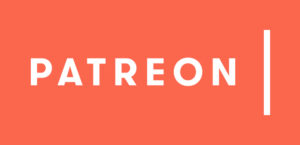 There are two sets of people on the Patreon site:
There are two sets of people on the Patreon site:
- Creators, the artists creating work and soliciting donations.
- Patrons, the fans pledging small amounts of money in return for access and content.
When you sign up to Patreon as a creator the welcome email states that you have “officially joined 50,000+ creators who run their creative businesses on Patreon“. If that’s true, that’s a large number of people who are making a living from voluntary donations in return for creative works. A good sign of the times for emerging filmmakers. Let’s take a look at the data behind their stated numbers.
Through my research, I have gathered data on 365,701 Patreon creator pages. That’s over seven times more than the figure Patreon quote in their welcome email. However, their email refers to “creators who run their creative business on Patreon“. This would mean we would need to exclude all the creator accounts who don’t have any active patrons donating money.
85% of Patreon users have zero patrons, leaving 55,920 accounts with at least one paying patron. Fewer than 1.3% of Patron users have more than 50 paying patrons.
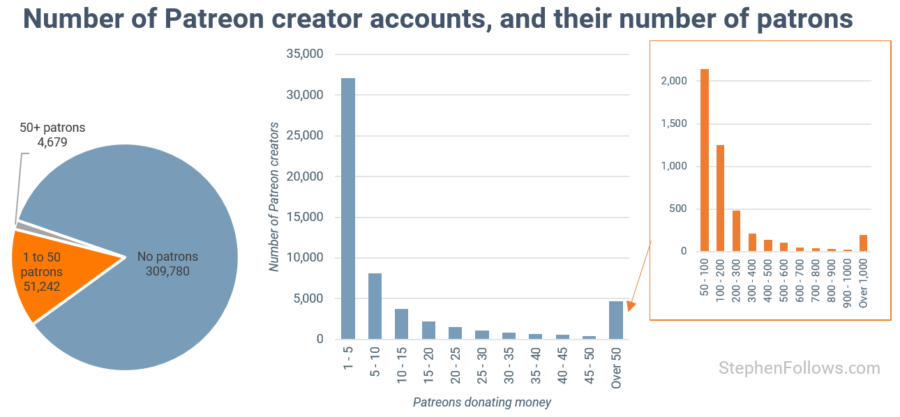
The most common category of Patreon creators is that of Video, which accounts for 35% of all creators.
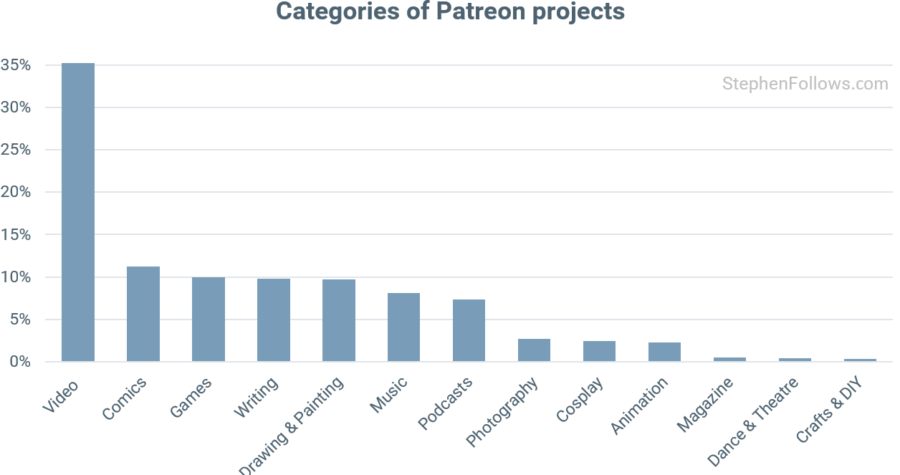
Part 2: How are they using it?
When setting up their Patreon page, creators have to state what they are creating. This is expressed in a standardised form of : [Creator’s name] is creating [what they’re making]. I.e. Stephen Follows is creating researched articles on the film industry. I counted the most common words in the second part of that sentence, to give us a clue as to what types of creations are supported on Patreon.
42% of Patreon creators are creating video-based content. That’s 154,797 people seeking support for their video creations. In the previous section, we saw how only 35% of Patreon projects are classed as ‘Video’, meaning that there are a number of projects which are producing videos but which see another category as their main descriptor. This could include music video producers who feel their work is best described as ‘Music’ but who charge patrons for each video they upload.
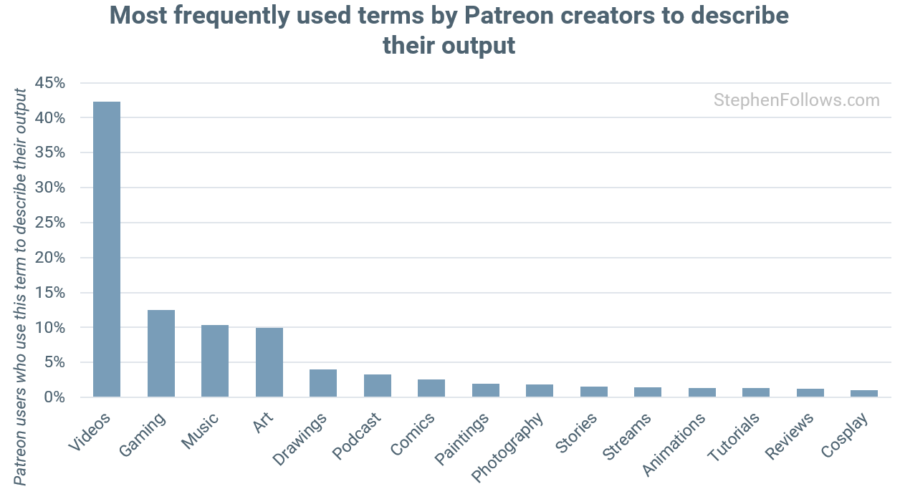
If we narrow our focus to just those creating videos, we can get a sense of what types of videos they are making. The chart below shows the most commonly used words used ahead of the words ‘video’ or ‘videos’. ‘YouTube video’ is the most commonly used phrase, followed by ‘Gaming video’ and ‘Music video’.
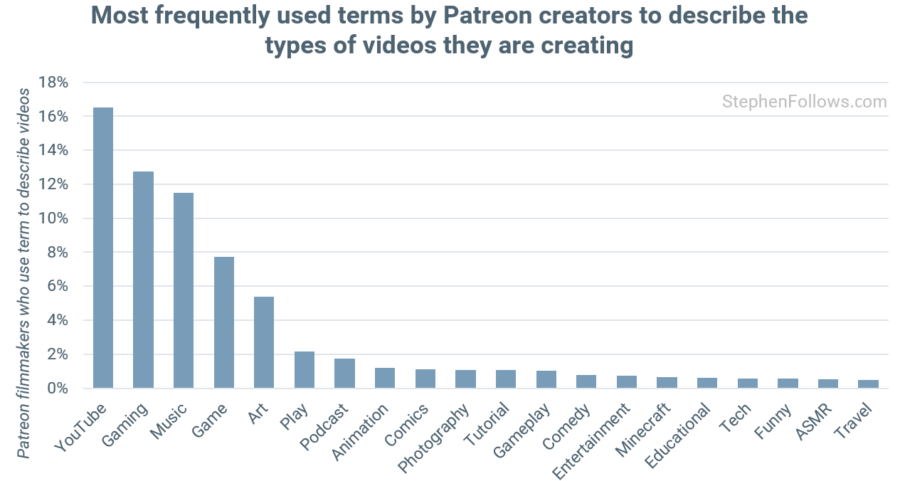
One of the appeals of Patreon seems to be its flexible understanding of the breadth of creative products. Creators are free to describe what they’re creating how they wish, which opens the site up to a myriad of different content creators. Among the more interesting projects I found were:
- Dubai Enjoy is creating Indian Escorts in Dubai
- The Same Picture of Shia Labeouf Every Day is creating The Same Picture of Shia LaBeouf Every Day. Donations are charged every time they publish the same picture of Shia LaBeouf every day. (Check out the picture from last Thursday – very moving).
- Jo Lindsay Walton is creating lies. Among the rewards on offer include:
- $5 or more: ill sort u out. oh, you’ll get your “reward
- $10 or more: there is a real reward for $10
- $20 or more: can’t tell you about it but pretty amazing
- $250 or more: have your back never let you dwon
- $ 700 or more: maybe you’ve done or a crime or smothething – I go in your place
- $16,0000 or more: love
There is also a sizeable number of NSFW (a.k.a. Not Safe For Work) projects which contain adult content or themes. Across all Patreon projects with at least one patron, 20% are marked as NSFW. This rises to 27% if we focus on the 1,000 most successful creators, suggesting that NFSW projects have a higher success rate than the less salacious.
The category with the highest percentage of NSFW content is Photography (57% NSFW) and the least is Music (5%).
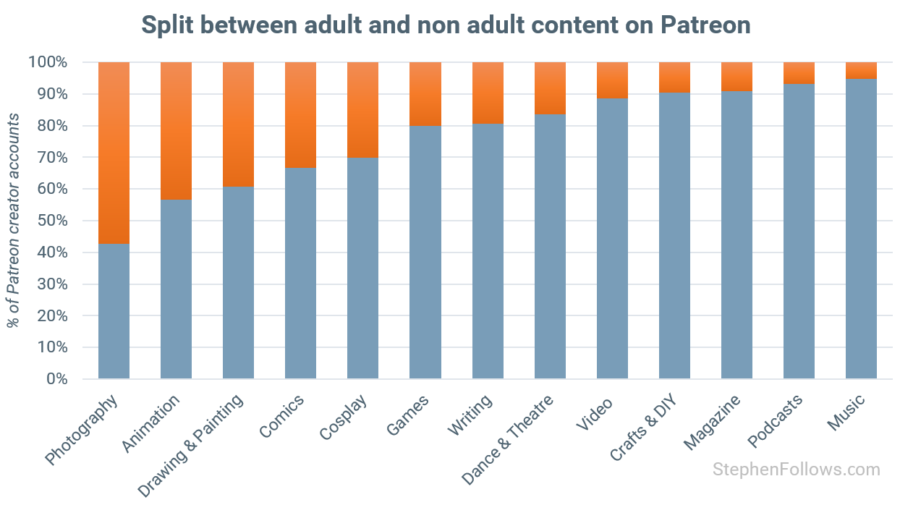
Part 3: How are Patreon creators earning?
As well as defining what content they are creating, Patreon creators need to state what action will trigger their patrons being charged. This could be time-based (i.e. once a month) or creation based (i.e. whenever they publish a new video). As with the type of content, they have a huge amount of freedom to define their own payment schedule.
70% of Patreon creators asked for money on a time-based schedule, with the most popular being a monthly payment. Only 1.3% of Patreon creators on a time-based schedule use something other than a month to define payments. A few creators are playing the long game by asking for money every 100 years, 900 years, 9,001 years and one is even asking for money once every 100,000,000 years.
The 30% of Patreon creators who do not use time to define when their patrons should be charged use a variety of milestones. The most popular of these is whenever they publish a new video.
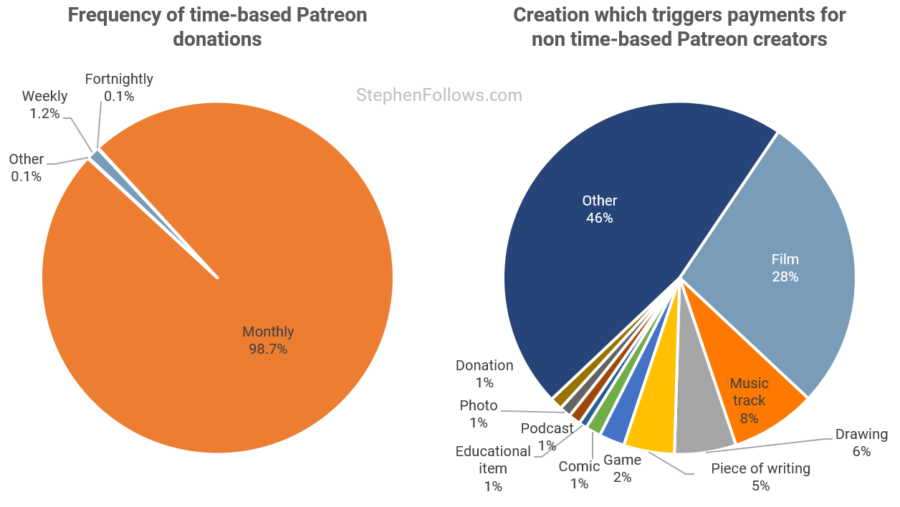
Note: The category ‘Donation’ above refers to when creators have stated that they will charge their users whenever they produce ‘nothing’ or when they want a ‘donation’. This is a slightly strange group but it is a mix of non-serious accounts asking for money for nothing and retired Patreon accounts which are no longer active or on hiatus.
Seeing as there is no cost or barrier to setting up a Patreon account, it is perhaps not surprising that the vast majority of Patreon creators do not earn anything from the site. Patreon gives creators the ability to hide how much money they are making, however, the site Graphtreon tracks top Patreon creators and estimates the amounts paid out each month. At the start of 2016, fewer than 5,700 creators were earning at least $300 a month. By August this year, this had grown two-and-a-half times to 14,383.
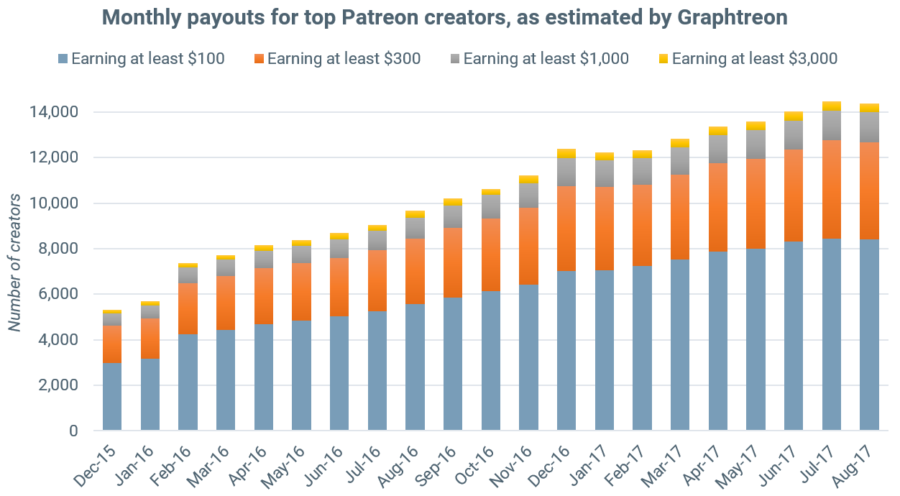
Bonus: The Patreon creators with the highest number of patrons
To end on an image of what Patreon success looks like, below is a table showing the 50 most successful creators, as defined by their number of patrons.
| Creator | Is creating... | Patrons | Income | Per | |
|---|---|---|---|---|---|
| 1 | Chapo Trap House | Chapo Trap House Podcast | 17,875 | $79,345 | month |
| 2 | Philip DeFranco | a News and Entertainment Network | 15,383 | ||
| 3 | Amanda Palmer | Art | 10,958 | $37,866 | thing |
| 4 | Sam Harris | The Waking Up Podcast | 9,536 | ||
| 5 | Kurzgesagt – In a Nutshell | Science Animation Videos | 9,176 | $33,097 | month |
| 6 | Second Captains | The World Service Podcasts | 7,937 | ||
| 7 | CGP Grey | Youtube videos | 7,698 | $19,752 | Video |
| 8 | Crash Course | Smarter People | 7,549 | $27,936 | month |
| 9 | AvE | COOL SHIT | 6,799 | ||
| 10 | Kinda Funny | Internet videos and podcasts | 6,383 | ||
| 11 | S&S | The Sword and Scale Podcast | 5,995 | ||
| 12 | Easy Allies | Video Game Streams and Shows | 5,961 | $40,196 | month |
| 13 | Fenoxo Fenfen | Adult INTERACTIVE FICTION | 5,813 | $30,382 | month |
| 14 | SciShow | YouTube Videos about Science | 5,744 | $21,395 | month |
| 15 | Jim Sterling | The Jimquisition | 5,736 | $11,933 | month |
| 16 | Dr Jordan B Peterson | lectures about profound psychological ideas | 5,468 | $60,480 | month |
| 17 | Forgotten Weapons | Videos, Articles, Photos, and Documents | 5,399 | ||
| 18 | Secular Talk with Kyle Kulinski | News & Political Commentary | 5,377 | $17,682 | month |
| 19 | Sakimi Chan | Art,Painting, Tutorials,Yaoi/Yuri/ Nude pinups | 5,353 | ||
| 20 | DarkCookie | Summertime Saga | 5,324 | $16,165 | month |
| 21 | Jeph Jacques | Comics | 5,315 | ||
| 22 | Mike Inel | animations and art | 5,079 | ||
| 23 | The SimBro team | adult video games | 5,023 | $10,918 | month |
| 24 | Redamz | Monster Girl Island | 4,923 | $27,631 | month |
| 25 | Clickspring | Home Machine Shop Project Videos | 4,871 | ||
| 26 | Seriallos | Raidbots | 4,854 | ||
| 27 | Colin's Last Stand | videos on politics and history | 4,843 | ||
| 28 | Kinda Funny Games | Videos and Podcasts | 4,805 | ||
| 29 | Daily Tech News Show | Podcasts | 4,649 | $16,344 | month |
| 30 | Wait But Why | high-quality blog posts | 4,539 | ||
| 31 | Home Free | music videos | 4,535 | $29,306 | video |
| 32 | Team Cemu | emulation software | 4,453 | $18,520 | month |
| 33 | Every Frame a Painting | Video Essays | 4,421 | $7,754 | video |
| 34 | Blind Wave | Videos | 4,415 | $25,700 | month |
| 35 | RollPlay® | Table Top Content | 4,361 | ||
| 36 | Last Podcast On The Left | Podcasts | 4,350 | $23,934 | month |
| 37 | Danny O'Dwyer | Video Game Documentaries | 4,274 | $21,849 | month |
| 38 | The Rubin Report | a talk show about big ideas and free speech. | 4,256 | $26,308 | month |
| 39 | Red Letter Media | weird internet videos and films | 4,214 | $19,046 | month |
| 40 | The Cum Boys | Cum Town Podcast | 4,211 | $18,934 | month |
| 41 | The Comedy Button | Weekly Podcasts and Videos | 4,188 | $8,983 | month |
| 42 | Laisvės TV | TV Show | 4,090 | $13,573 | month |
| 43 | Extra Credits | History That's Fun To Watch | 4,075 | $14,995 | month |
| 44 | Nerd³ | Videos, Words and Games | 3,961 | $7,468 | month |
| 45 | Indy Neidell | THE GREAT WAR DOCUMENTARY SERIES | 3,944 | $17,073 | month |
| 46 | InRange TV | The best firearms video content | 3,927 | ||
| 47 | Studio FOW | crazy videogame porn | 3,866 | ||
| 48 | The Pod | PC and Video Gaming Podcasts | 3,825 | $18,477 | month |
| 49 | Peter Hollens | Music Videos | 3,689 | ||
| 50 | Pentatonix | Music Videos | 3,629 | $18,094 | Music Video |
Notes
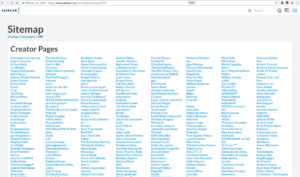 Patreon handily publishes a sitemap, listing every project on their platform. This gave me my master list of projects. From there I was able to gather the public data from each creator’s page and organise the data into my own database. From what I can tell, this means we can be fairly confident that this research covers all projects at the time of writing. This gave me data on:
Patreon handily publishes a sitemap, listing every project on their platform. This gave me my master list of projects. From there I was able to gather the public data from each creator’s page and organise the data into my own database. From what I can tell, this means we can be fairly confident that this research covers all projects at the time of writing. This gave me data on:
- 365,701 Patreon creator pages
- 392,797 goals stated
- 814,371 rewards offered
- With a total of 10,398,522 data points to study.
I conducted my data gathering in August 2017. The further you are reading this from that date, the higher chance that the economics of Patreon have changed. This is a very fast moving sector and one where trends can shift quickly.
Patreon gives its creator a huge amount of control of exactly what they’re creating and the frequency of when they will deliver it. I built smart algorithms to sort and classify the data, and then manually checked unusual cases. Even so, I couldn’t manually check all 366k entries. In addition, some of the combinations defy easy classification, such as when looking at whether the patrons were being charged by time or by creation, I was presented with entries such as “per song, album, video, month, etc.“. In these rare cases, they will be classed as both ‘time based’ and ‘creations based’.
When looking at what creations are being supported, I grouped the results to put similar terms together. For example, ‘Video’ included those who used the terms videos, vlogs and YouTube, ‘Drawings’ include drawing and illustration, and so on. This method is not without its limitations. For example, it brings together those creating games and those making content around games (i.e. reviews, playthroughs, etc).
When I conduct deep data dives into such topics, I often get requests from commercial business to buy or access the data I collected. I have never, and will never, sell or give away such datasets. This research is wholly non-commercial and only for the educational benefit of the community. However, if you have a question you think the data could answer but which I have not yet covered, please do drop me a line or leave a message in the comments below.
I am not affiliated or authorised by Patreon in any way. I have not been in touch with them, nor induced in any way to write this article; this is fully independent and dispassionate research.
Epilogue
 When I was a film student in the early 2000s we were told that only fools put ‘Filmmaker’ on their business card and identify it as their profession. Being a ‘filmmaker’ was not a job, no-one hired filmmakers and it just revealed the naive nature of the individual involved. Instead, we were told that success in the film industry comes via only one of two routes:
When I was a film student in the early 2000s we were told that only fools put ‘Filmmaker’ on their business card and identify it as their profession. Being a ‘filmmaker’ was not a job, no-one hired filmmakers and it just revealed the naive nature of the individual involved. Instead, we were told that success in the film industry comes via only one of two routes:
- Join an existing structure, such as starting as a runner and slowly moving up to producer or director; or
- Build a new structure, by raising many thousands of pounds to make an independent film, following the paths of heroes like Quentin Tarantino and Robert Rodriguez.
There was no route for the lone filmmaker (unless you were rich). I distinctly remember a tutor telling my fellow film student Chris that “If you want to put a sign on your bedroom door which reads ‘Filmmaker’ then that’s fine but it’s not a job”.
Fifteen years later and it’s possible that a significant proportion of the highest paid filmmakers under 25 years-old are creating their content out of their bedrooms, by themselves. And they are doing this without the need to raise large sums of money up front and without the need for permission from any film industry gatekeepers. The role of “Filmmaker” is no longer a delusion of keen film students – it’s a career option.
This is an exciting progression and one which continues to evolve. Viva la revolución!

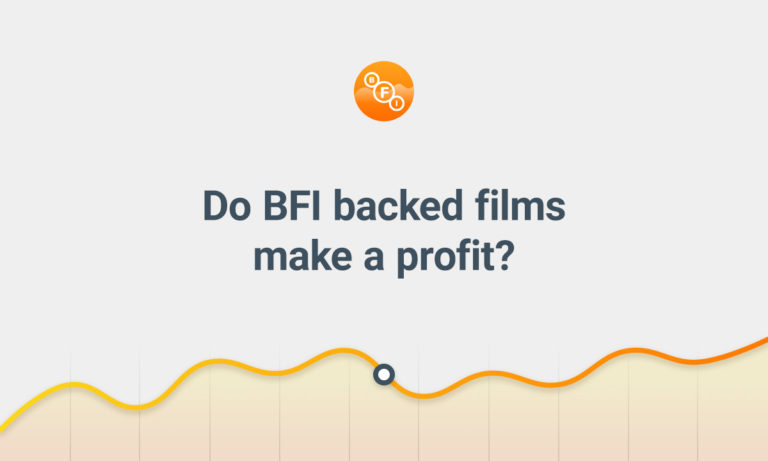
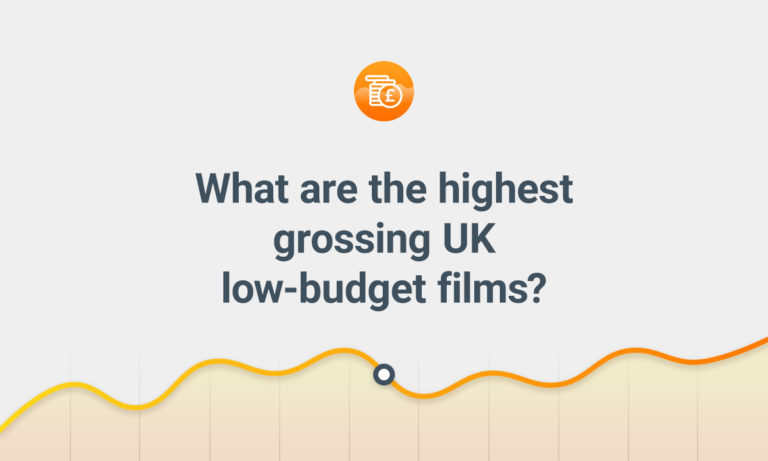
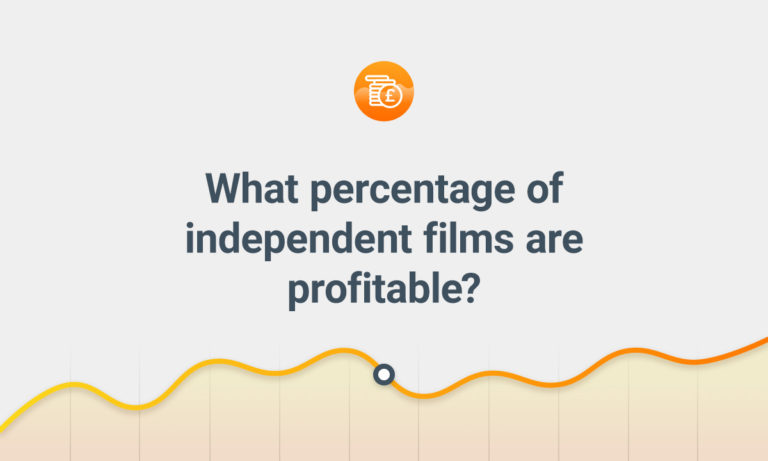

Comments
Compelling research, Stephen! I’d been curious about how Patreon was growing / being used, and it’s helpful to know how much of it is driven by video content. Thanks for the great analysis!
Fantastic research and thoughts as always Stephen.
It would be interesting to know if any of the content created is narrative or fiction lead..? By the looks of it, the majority of the video content is in a documentary and/or vlogging style and format. With the occasional music video.
Do you think the inherent expense of narrative filmmaking at scale is prohibitive to the business model Patreon is providing for creators?